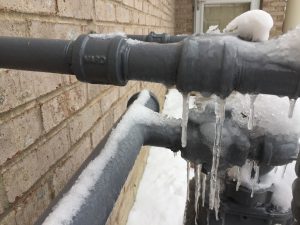How to Defend Pipes from Freezing: Specialist Advice
How to Defend Pipes from Freezing: Specialist Advice
Blog Article
This post underneath on the subject of Preventing and dealing with frozen pipes is pretty much entertaining. Check it out yourself and decide what you think of it.

Winter can damage your plumbing, specifically by freezing pipes. Here's how to prevent it from happening and what to do if it does.
Introduction
As temperature levels decline, the danger of frozen pipes boosts, potentially leading to expensive repair work and water damages. Comprehending just how to avoid icy pipes is crucial for property owners in cold climates.
Prevention Tips
Shielding susceptible pipelines
Wrap pipes in insulation sleeves or use warm tape to protect them from freezing temperature levels. Focus on pipes in unheated or outside areas of the home.
Home heating techniques
Maintain interior spaces properly heated up, especially locations with pipes. Open up cabinet doors to enable warm air to distribute around pipes under sinks.
Just how to identify frozen pipes
Search for decreased water flow from faucets, uncommon smells or sounds from pipelines, and noticeable frost on exposed pipes.
Long-Term Solutions
Architectural modifications
Consider rerouting pipelines far from exterior wall surfaces or unheated areas. Include additional insulation to attic rooms, basements, and crawl spaces.
Updating insulation
Purchase premium insulation for pipes, attics, and wall surfaces. Proper insulation helps maintain consistent temperature levels and minimizes the threat of icy pipes.
Shielding Outdoor Plumbing
Garden pipes and outdoor faucets
Disconnect and drain pipes yard hose pipes before winter season. Set up frost-proof faucets or cover outdoor faucets with insulated caps.
Understanding Icy Pipes
What creates pipelines to ice up?
Pipes freeze when revealed to temperatures below 32 ° F (0 ° C) for expanded periods. As water inside the pipelines freezes, it increases, putting pressure on the pipeline walls and possibly causing them to rupture.
Threats and damages
Icy pipes can lead to water system disruptions, residential property damages, and costly repair work. Ruptured pipes can flooding homes and cause substantial architectural damage.
Indications of Frozen Pipeline
Recognizing icy pipelines early can prevent them from breaking.
What to Do If Your Pipelines Freeze
Immediate actions to take
If you suspect icy pipelines, maintain taps available to alleviate stress as the ice melts. Utilize a hairdryer or towels taken in warm water to thaw pipelines slowly.
Conclusion
Protecting against icy pipelines calls for aggressive steps and quick feedbacks. By comprehending the reasons, signs, and preventive measures, home owners can secure their pipes during winter.
5 Ways to Prevent Frozen Pipes
Drain Outdoor Faucets and Disconnect Hoses
First, close the shut-off valve that controls the flow of water in the pipe to your outdoor faucet. Then, head outside to disconnect and drain your hose and open the outdoor faucet to allow the water to completely drain out of the line. Turn off the faucet when done. Finally, head back to the shut-off valve and drain the remaining water inside the pipe into a bucket or container. Additionally, if you have a home irrigation system, you should consider hiring an expert to clear the system of water each year.
Insulate Pipes
One of the best and most cost-effective methods for preventing frozen water pipes is to wrap your pipes with insulation. This is especially important for areas in your home that aren’t exposed to heat, such as an attic. We suggest using foam sleeves, which can typically be found at your local hardware store.
Keep Heat Running at 65
Your pipes are located inside your walls, and the temperature there is much colder than the rest of the house. To prevent your pipes from freezing, The Insurance Information Institute suggests that you keep your home heated to at least 65 degrees, even when traveling. You may want to invest in smart devices that can keep an eye on the temperature in your home while you’re away.
Leave Water Dripping
Moving water — even a small trickle — can prevent ice from forming inside your pipes. When freezing temps are imminent, start a drip of water from all faucets that serve exposed pipes. Leaving a few faucets running will also help relieve pressure inside the pipes and help prevent a rupture if the water inside freezes.
Open Cupboard Doors
Warm your kitchen and bathroom pipes by opening cupboards and vanities. You should also leave your interior doors ajar to help warm air circulate evenly throughout your home.

I hope you enjoyed our part about How To Avoid Freezing Pipes. Thanks a lot for spending some time to read through our short article. Do you know anybody else who is curious about the topic? Feel free to share it. Thanks for taking the time to read it.
Book Maintenance Report this page